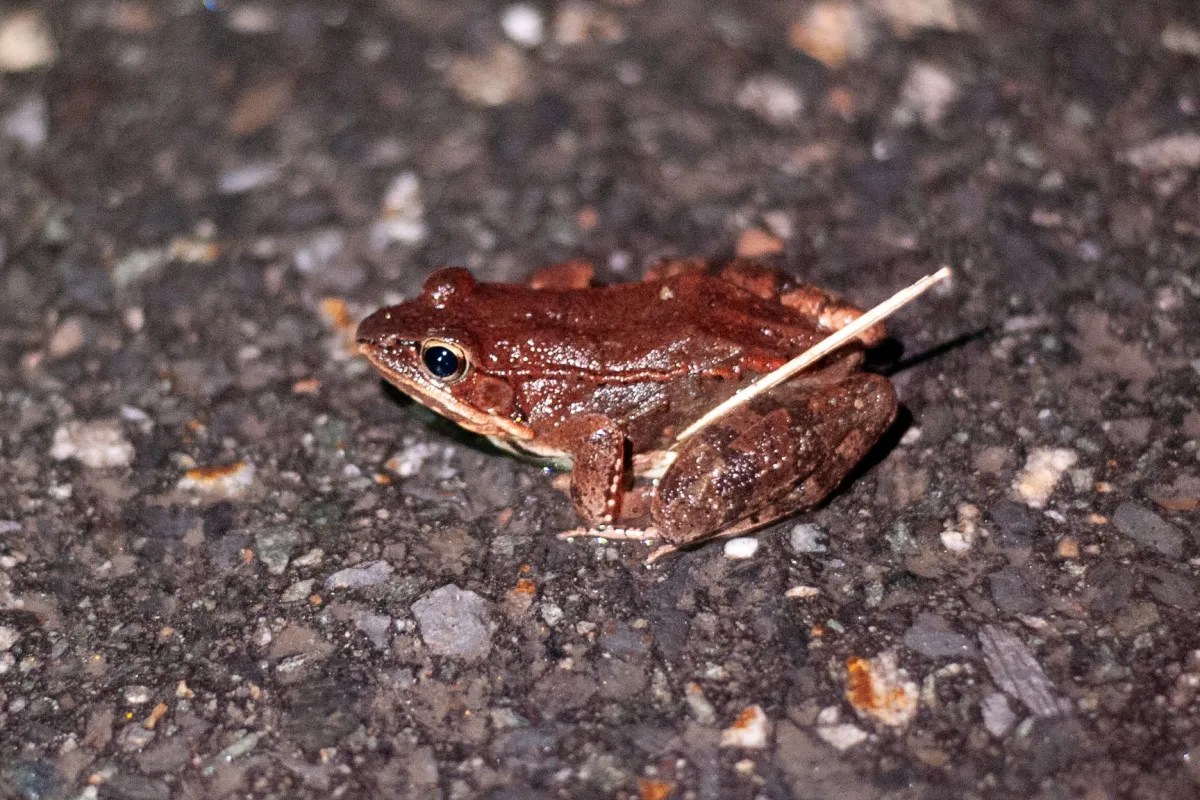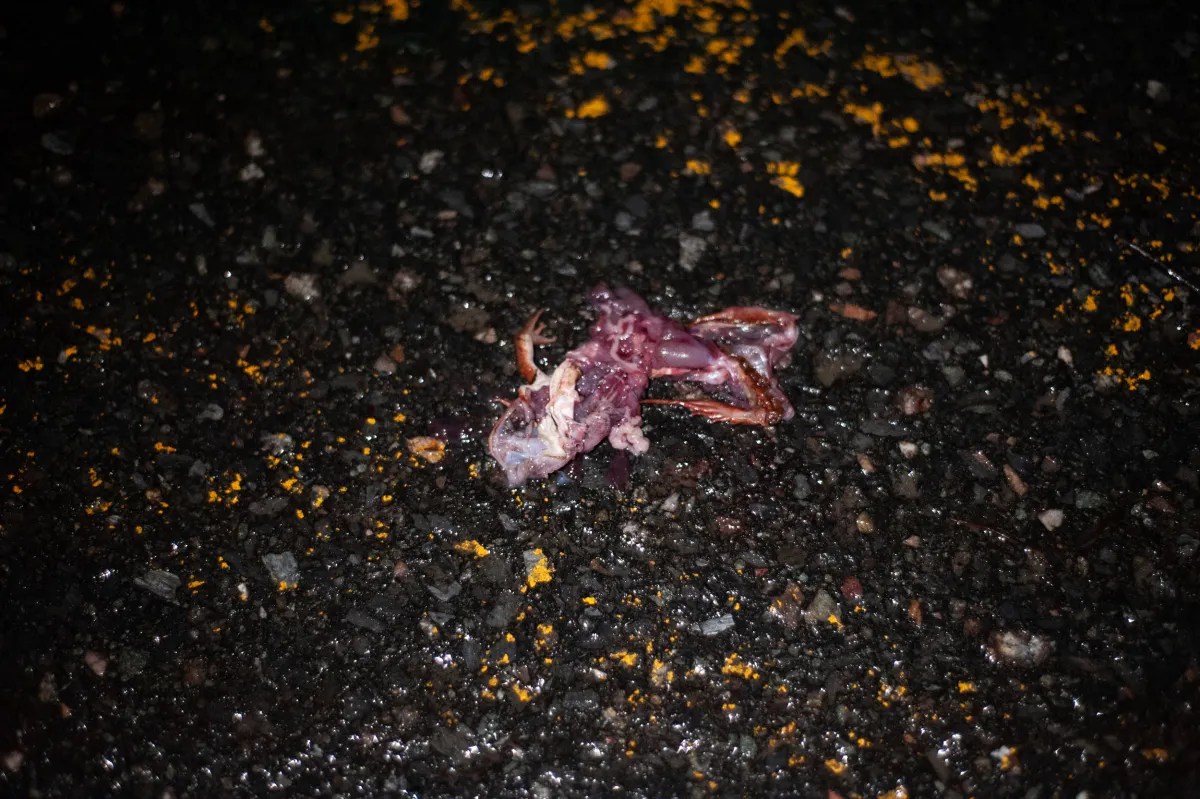
MONTPELIER — The duo heard them long before seeing them, a wild cacophony from the darkness beyond the road. The throaty ribbits were wood frogs. The flighty chirps were minuscule spring peepers, small as a thumbnail. But what the pair was looking for was silent.
“Here,” said Sean Beckett, reaching into the water. “Look.”
In his open hand rested a yellow-spotted salamander, calm and unmoving. Under the glare of Beckett’s headlamp, its body was an almost translucent purple, with bright yellow spots painted down its back. Breathing softly, its eyes were globed and black, its long mouth like a kindly dragon’s.
“It’s an amazing wildlife ambassador,” said Beckett, releasing the creature back into the water.
Beckett and his wife, Allison Waring, were at a vernal pool at the end of Cummings Street, in Montpelier. These are seasonal ponds where amphibians mate on the first rainy nights in spring. They were there on Friday, a dark, muggy, drizzling night — perfect migratory conditions — and the pool was loud with hundreds of anxious frogs.
“These are mating right now,” Beckett laughed, swinging his flashlight onto a busy wood frog couple.

Beckett is programs director at North Branch Nature Center, a nonprofit dedicated to connecting people with nature, where he designs courses, birdwalks, classes, and even leads wildlife safaris. He is soft-spoken and often awe-struck, full of “woahs” and “awesomes” at the sight of rare newts. He is also an enthusiastic teacher. He translates science into layman’s terms with an easy didactic fluency.
Beckett estimated that in the three nights from Wednesday to Friday, about 95% of amphibians in the area abandoned winter quarters and migrated toward vernal pools. That means thousands upon thousands of frogs, newts, salamanders and toads hopping, skipping and sliding down hillsides in the dark — and across dangerous roads.
“In some species the highest cause of death is car tires,” said Beckett.
Amphibians are a key part of Vermont’s woodland ecosystem, eating bugs and providing food for predators like snakes and raptors. But road mortality on migration nights can tank population levels, according to Beckett, especially when compounded year on year.

This is why, in 2018, he and a colleague founded the Amphibian Road Crossing program, a squad of volunteers that fan out across migration sites on rainy spring nights, helping the little creatures cross the road. Since its inception six years ago, the program has spread to community organizations across the state, with more than 20,000 amphibians rescued, according to Beckett.
But the amphibian ferry service is just one part of what A.R.C. is about.
“We’re also collecting data in a really systematic way,” Beckett said.
Each volunteer carries with them a survey sheet, meticulously recording the weather, cars driving by, and amphibians they see. This data is later uploaded to the North Branch Nature Center’s website, where it is input into a live map. The result is an impressive real-time overview of 346 migration sites in Vermont, drawing from more than a thousand volunteer surveys.

As Beckett drove north to one of these road crossings, swerving to avoid flattening spring peepers, he spoke about the importance of all this information.
“So, if we’re talking to a road commissioner, he can look at our map and pop up that road and see all the data for it,” said Beckett, pointing to the possibility of road closures on migration nights.
A more permanent solution is to use the map to convince municipalities to build migration underpasses like those in Monkton, which have been a huge success since their construction in 2016.
Once in Middlesex, Beckett pulled off onto the side of Shady Rill Road. As he and Waring began the survey, the scale of the horror unfolded before them. Every few steps there was another mangled amphibian carcass, then another, and another. The toads lay with legs splayed, belly-seams split open, tattered guts in a pile outside the body. Some frogs were so run over they were two-dimensional, more imprints than objects. Beckett scraped the dead ones off the pavement with a spatula.
“Spring peeper, dead!” he called.
Waring duly noted it on the survey sheet. Thwick, went the spatula, and the peeper flew into the darkness on the side of the road.

Beckett paused before the limp body of an Eastern newt.
“A newt waits five years to reach reproductive maturity, for this night, just to get squashed.”
He sighed, shook his head. Thwick, went the spatula.
They walked only an eighth of a mile down the road, but it took them over half an hour. At the end, the tally stood at:
— Dead: 22 spring peepers, 5 American toads, 4 Eastern newts, 3 yellow-spotted salamanders, 3 wood frogs, and 1 mortally injured dusky salamander.
— Alive (Rescued): 5 spring peepers, 1 American toad.
Beckett mentioned the yellow-spotted salamander at the vernal pool in Cummings Street. At least they got to see one alive there. But as they make their way back, tallying up the freshly dead, a sudden movement.



Short legs treading like a komodo dragon, belly down close to the pavement, a back undulating with yellow spots.
Beckett scooped it up and lowered it down beyond the road, away from the incoming headlights of a truck.


